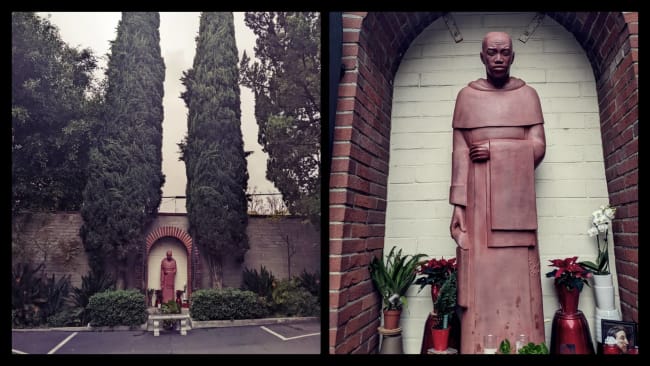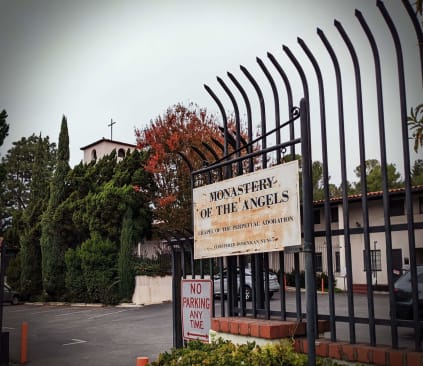To the Catholic faithful and Hollywood community members who have visited the Monastery of the Angels since it was established on Carmen Avenue almost 100 years ago, it is a place of spiritual peace, architectural and natural beauty and the source of scrumptious pumpkin bread–an oasis in the shadow of the roaring 101 Freeway.
Less well known is how significant the Monastery is within the broader history of the Catholic church. For the resident Dominican Nuns of the Sacred Order of Preachers (established near Toulouse, France in 1206) have the distinction of being the first religious order in the United States to have Perpetual Adoration of the Eucharist.
The first four Dominican sisters came to America from Oullins, France in 1880 and took up residence in a new cloister in Newark, NJ. Dominican daughter monasteries would be established in the Bronx, NY (1889), Union City, NJ (1891), Milwaukee, WI (1897), Catonsville, MD (1899), Camden, NJ (1900), Buffalo, NY (1905), Detroit, MI (1906) and La Cross, WI (1909) as the order grew and populated the United States.

Blessed Mother Mary Inspiring St. Dominic With the Rosary By Gemma D’Auria
On St. Patrick’s Day 1924, in response to Sister Mary of the Eucharist’s request, Archbishop John J. Cantwell invited her and four other nuns from the Newark monastery to live in Los Angeles as the city’s first community of cloistered Catholic women. The Dominicans took up residence at 728 West 28th Street near Exposition Park, in the elegant former home of mining geologist Horace Winchell. The 12-room property was known for a decade as the Monastery of the Angels, and hosted within it a Chapel of Perpetual Adoration where the public could come and pray with the sisters. But for nuns to live cloistered lives in a converted house on an ordinary residential street required significant effort.
In 1934, the sisters obtained a more suitable home when their order, with the aid of wealthy friends, purchased the former mansion of Nevada copper king Joseph Louis Giroux, on Carmen Avenue in Hollywood. The house had been designed by master architect Frederick Roehrig in 1912, with landscaped gardens by Arthur E. Simpson. The grounds included vast lawns, terraces, fountains, rare specimen plants and long driveways lined with palms.

Among the patrons who helped the sisters seal the deal were members of the Brunswig, Doheny, Keller and Von Der Ahe (Vons Markets) families, and attorney and civic leader Joseph Scott. You might be asking yourself, what kind of place was Hollywood for a cloistered religious community? And indeed, when she first met with her realtor, prioress Mother Mary Gabriel said “Show me anywhere but Hollywood!” Like so many who migrated to the booming city in the 1920s, she associated Hollywood with sin and cinema. But the Hollywood subdivision had been founded by Kansas teetotalers, and in its early years was known for its beautiful gardens, churches, spiritual communes and fine mansions, all set back from the main boulevards among orchards.

And as the agent explained, despite the stigma of the Hollywood name, there really was no more suitable site for a Dominican monastery in Los Angeles than the Giroux mansion. And so was established the faith community that would inspire many news stories over the decades that contrasted the grime and bustle of Hollywood Boulevard with the peaceful, timeless lives of the nuns just a few blocks north.

For 14 years, they lived and prayed in the mansion. In Spring 1948, the Catholic women of Los Angeles came together in the Crystal Room of the Beverly Hills Hotel to fundraise for the sisters' new purpose built cloister, chapel and office complex. Maureen O’Sullivan was the chairwoman, and sponsors included Edith Head, Louella Parsons, Irene Dunne and the society reporter Princess Conchita Sepulveda Pignatelli.
Designed by Wallace Neff in the Spanish Colonial Revival style, the new complex enclosed the old mansion monastery and its 4 acres of grounds with 18' tall walls. In their new cloister, the nuns lived in spare 7 1/2 x 10' cells as Dominican sisters had done since the early 13th century, sleeping in their rough habits, to be ready to get up and chant and pray in the proscribed fashion throughout the night, every night, for all of their lives.

Monastery Of The Angels Chapel
Sculptures and reliefs by the Hollywood screenwriter Gemma d’Auria were commissioned, including the stations of the cross in the courtyard next to the chapel, and the figure of Martin de Porres, the first black American saint, in the parking lot.

Martin De Porres by Gemma D’Auria
By 1950, there was a community of 30 cloistered nuns living, working and practicing Perpetual Adoration in their simple chapel, with at least four nuns praying at all times. The sisters ate a spare pescatarian diet with just one meal daily from the Feast of the Holy Cross (September 14) to Easter Sunday, slept on straw mattresses, baked communion wafers for local churches, sewed vestry garments for the priests, tended their flower garden and ministered to the sick and needy who came to the chapel to speak through the metal grill that separates the cloistered sisters from the world outside.

Monastery of the Angels Parking Lot Entrance
The nuns were able to remain in their cloister in constant prayer thanks to the support of the Los Angeles Catholic community, which organized star-studded fundraising teas and fashion shows–Bing Crosby and Don Ameche were regular performers–and remembered the sisters in their wills.
Although it is a cloistered community, Wallace Neff designed the new Monastery of the Angels campus with a public face. The chapel where the nuns and their lay visitors engage in Perpetual Adoration is just a few steps up from the public parking lot. And opposite the chapel door is the gift shop, where visitors can purchase spiritual books, medallions, prayer cards and the famous pumpkin bread and hand-dipped chocolate candies that help support the monastery.

Monastery Of The Angels Gift Shop & cardboard cutout of Sister Mary Gabrielle
In 1972, Sister Mary Agnes Burton baked her Canadian grandmother’s pumpkin bread recipe for the communal meal. It proved to be a delicious and economical solution to the problem of rising fruitcake ingredient costs. By 1986, an assembly line of 26 nuns was producing 12,000 loaves a year and bakery sales made up 25% of the monastery’s income.
As for the old Giroux Mansion, it remained in service as a retreat house for Catholic women seeking a respite from the modern world until May 1973, when all of the decorative elements that could be salvaged–stained glass, hand-carved bookcases, pre-Raphaelite fireplace tiles, cement planters, Italian roof tiles and the copper king’s copper doorknobs and bathtubs–were auctioned off to benefit construction of a modern retreat house facing Gower Street. The mansion was then demolished. All that remains today are the grand terraced stairs.

Public Garden & Stations Of The Cross by Gemma D’Auria
In recent years, the Monastery has suffered from financial problems and a declining membership. In 2009, when the global financial crisis raised the specter of the Monastery of the Angels closing and the land being sold for redevelopment, there were 20 women living in the cloister. After several nuns died or moved into assisted living facilities during the COVID pandemic, there were just 4 women remaining at last count.
In 1950, prioress Mother Mary Gabriel told a reporter “Our prayers are for all the world and in particular Los Angeles in this age of destruction and confusion.” In 1959, after thirty years of service in Hollywood, Mary Gabriel moved to Karachi, Pakistan to establish a cloistered monastery, also called Monastery of the Angels, to minister to the largely Muslim community. While today the Hollywood monastery is a shadow of itself, its Pakistani sister is thriving.
Los Angeles and all the world need the prayers more than ever. The Monastery of the Angels must remain as a sacred Catholic space in the heart of Hollywood.
